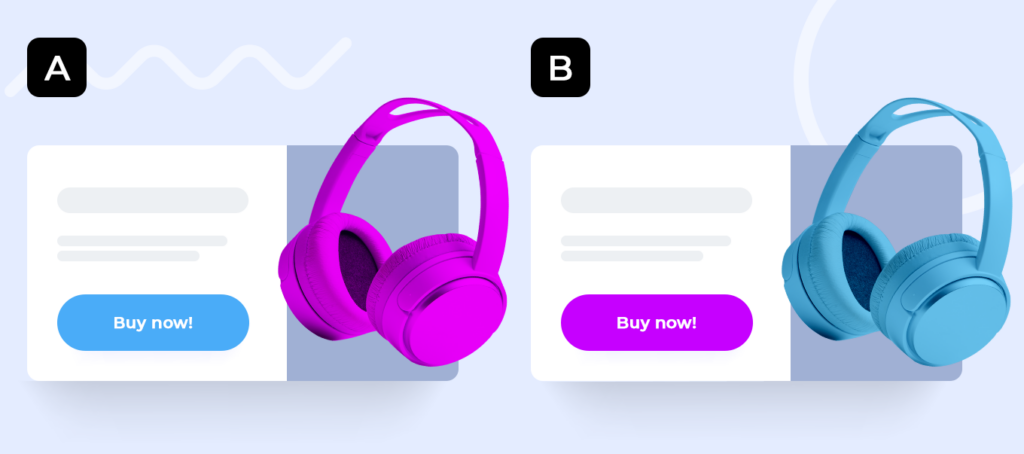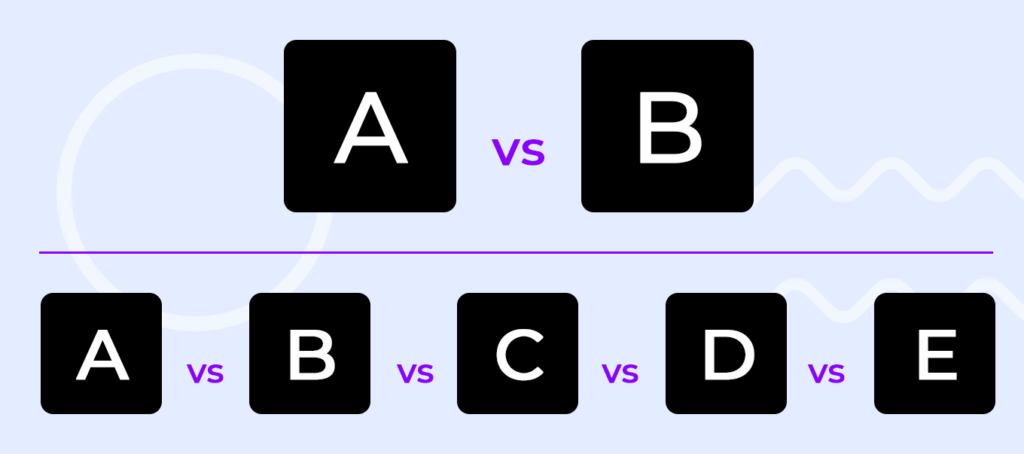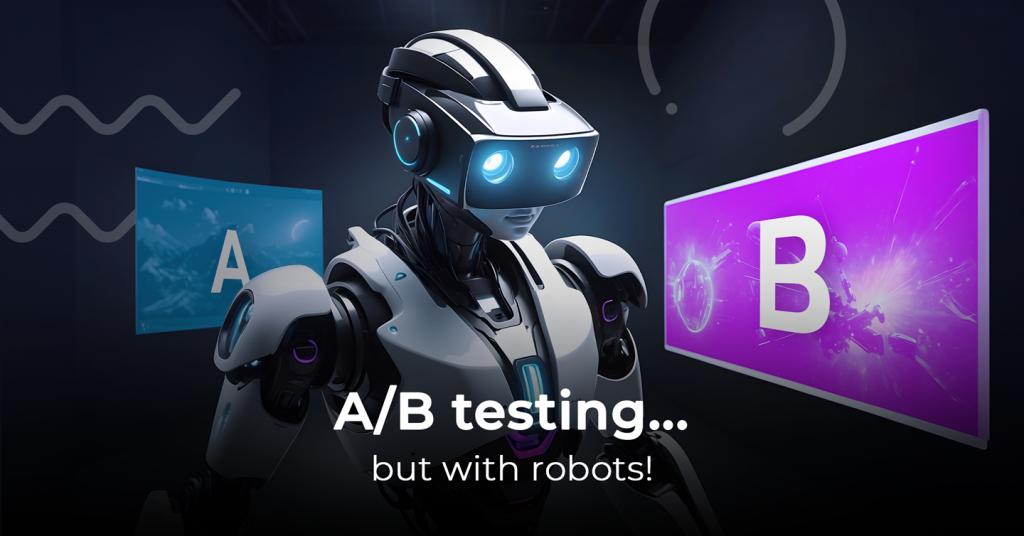A/B testing is a strategy present in every digital marketing educational material, be that blogs, webinars, ebooks or YouTube videos. It is the one thing that all marketing gurus are universally preaching: “If you are not doing A/B testing, you are doing the marketing wrong”.
This is true, with some asterisks attached.
Traditional A/B testing has its limitations. It requires more work to prepare ad or landing page variants and then later to analyze data. It may mislead, prevent further optimization efforts, and incorrectly generalize finding to a wider population.
Employing AI to do the A/B testing instead of a marketer alleviates some on these issues. You just need to use artificial intelligence in a smart way.
What is A/B testing?
A/B testing refers to publishing to variants of an asset on a digital touchpoint, A variant and B variant, to equal parts of traffic to see which one will yield more desired results. The assets include:
- Ad
- Landing page
- CTA
- Content
- Video
Marketers usually measure the following outcomes to assess, which variant is more successful.
- Clicks
- Purchases
- Signups
In a more concrete example, a marketer creates two variants of the same ad. To better identify a factor that brought more clicks, it is best when there’s only one small change between two variants: change in wording, different background color, etc. If the variant differ in several ways, adjusting the marketing campaign toward the winning ad would be more difficult.

So one of the two variants is displayed to visitors at random, usually in equal proportions. This means that each visitor has the same chance to see each variant. Most ad tracking software, CMRs or other platforms allow you to change the ratio, but the 50/50 split test brings the most conclusive result.
After some time, one ad should get more engagement (clicks, views) than the other. Then the winning ad becomes the default ad, and the losing ad is removed to maximize results.
What is required for a successful A/B test?
You cannot perform A/B testing in all circumstances. You need to make sure that you check the following boxes:
- Large volume of traffic. This is required to achieve statistical significance, i.e. so the results are conclusive.
- Time. You need to dedicate some time to testing to make sure that a decent number of people have interacted with your touchpoint.
- Measurement tool. You need to have a platform that gather and presents results in a easy to understand manner.
- Variant. You should think about which element of your digital touchpoint can have impact on your audience and then prepare variants of your asset.
What Are the Benefits of A/B Testing?
The main benefit of A/B testing is optimization. Optimization means that you are using the most attractive assets in the most efficient way. A/B testing may indicate a strategy change or at least trying a different angle, if, for example, a more aggressive headline gets more traffic.
A/B testing helps to understand your own audience better and can enable launching more eye catching campaigns in the future.
What are the Risks and limitations of A/B testing?
A/B testing have its caveats though, it’s not all sunshine and rainbow.
Firstly, it allows you to test only two variants at one time. This limits the number of elements you can put to the test and thus, may prevent you from finding the most optimal asset. There is an optimization technique called multivariate testing, where more elements are put to the test against each other, So, instead of A vs B, you evaluate A vs B vs C vs D vs E. But this requires more traffic and may bring inconclusive results.

Secondly, A/B testing does not bring personalized results. They are true for your general audience. You may find that dividing your traffic into smaller segments and adjusting your message toward their characteristics may ring better results. For example, mobile users may respond better to shorter headlines and more prominent CTAs while desktop users may appreciate the graphical part of your ad more. A/B technique assigns one variant or other at random, it doesn’t differentiate, does not try to fit into any context.
Thirdly, it brings static results that are true for the moment of conducting a test. Visitors’ needs may fluctuate and change and what was a winning variant past week might not have won the test this week.
AI-powered A/B testing
Ai A/B testing is the evolution of the static approach that was used in the digital marketing industry for years. It operates under the same principle but this time changes in traffic volume are managed by an algorithm.
So, instead or running a test for a fixed period of time, AI adjusts the distribution of traffic on the fly, using the selected metric as a marker of success.
Advanced AI can even keep testing alternative variants of an asset on a small portion of traffic even after clearly determined the winner to catch new trends, shifting behaviours and a potential for further optimization early on.
Benefits of AI A/B testing
The use of artificial intelligence in A/B testing allows to eliminate most of the issues of traditional A/B testing. The benefits include:
- Results are tuned automatically to represent the current visitor interest the most. This constant A/B testing would not be possible without the AI. A marketer doing traditional A/B testing has to, at some point, make a decision to stick to one ad, or one landing page in order to increase the desired results. But this rush to squeeze the most out of an ad dollar ignores the fact that some visitors did respond to a losing variant, and for them, this variant may be better. Sticking to just one variant, albeit still preferable for a general audience, may deter some users from clicking. AI can adjust the traffic distribution in a way that maximizes the potential of all variants.
- Scale and integrity. AI can handle huge traffic loads and can connect results from various touchpoints where the test is conducted. Traditional A/B testing didn’t work well when you had multiple channels, so your ad was present on your site in social media posts, on paid advertising channels and on video platform. And these ads, apart from different resolutions that enable it to fit better in a given context, may be the same across all channels.
Voluum A/B testing
Voluum ad tracking platform recognized the problems of manual testing long time ago and introduced a feature aptly named Traffic Distribution AI. It was designed with performance marketers in mind, who need to quickly test different landing pages or offers on large volumes of traffic.
Traffic Distribution AI can handle A/B testing or multivariate testing, if only traffic volume allows it. The way it works is that a marketer puts two or more elements (landing pages, offers, campaign paths) in one campaign, chooses a desired metric (ROI or Conversion rate) and enables Traffic Distribution AI with one toggle. The algorithm then starts the testing period.
During this period, traffic is distributed evenly between testing elements, so in case only two elements are added, 50% of traffic goes to one element and the remaining 50% goes to the other.
Once the testing period is completed, the algorithm starts adjusting the weights on the fly to always keep your campaigns at maximum efficiency.
AI-powered marketing is efficient marketing
Artificial intelligence brought marketers many tools, with AI-backed A/B testing being one of them, that help digital marketers do their job more efficiently, making the ad space more engaging for users. Overall, tested and proven ads create a more pleasant web browsing experience for all.











